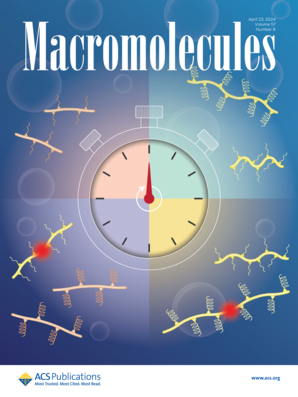Novel Insights into Solution Electrospinning for Nanofibers
IF 5.1
1区 化学
Q1 POLYMER SCIENCE
引用次数: 0
Abstract
To understand how nanofibers are formed by solution electrospinning, an in situ observation of the fluid flow is essential. In this study, the flow behavior of charged fluids from the Taylor cone, straight jet part, until whipping (or spiral) jet part along the spinline is explored via particle image velocimetry, light scattering, and high-speed videography, respectively. The results of light scattering reveal that the stretching rate in the straight jet exceeds the intrinsic rates of polymer relaxation in the fluid, derived from the dynamic rheological measurement, supporting the hypothesis of flow-induced phase separation and the resultant evolution of the dissipative structures, the so-called “string” structures, in the straight jet section. Using liquid nitrogen to collect the straight jet followed by freeze-drying, assembled strings with various widths are validated. Moreover, dynamic vortex flow is observed in the Taylor cone using particle image velocimetry, likely generating a swirling flow in the cone apex. The vorticity of the swirl is increased after passing the cone-jet transition zone, at which the electric field is the highest. Thereafter, the enhanced swirl gradually decays (or releases its imposed torsion) during its propagation along the straight jet via a jet twist. The straight jet with internal swirl is considered as the precursor of the spiral jet, given that the preimposed torsion in the straight jet is not completely relaxed at the straight jet end. Using high-speed videography, a transition of the handedness of the spiral jet, rotating either clockwise or counterclockwise, is repeatedly observed in a single spinning line, suggesting the intermittent entry of the swirl with different handedness in the cone apex. Thus, the downstream spiral jet is relevant to the upstream entry flow at the cone apex; this phenomenon resembles the classic extrusion instability. Helical fibers (or coils) are observed on the ground collector, as the residual torsion in the spiral jet is not fully released after solvent evaporation in the spinning line of the spun fiber. Our work shows that important external flow fields are applied to semidilute solutions through the electrospinning process, which self-organizes nanofibers as ordered structures from dissipative structures through thermal concentration fluctuations along the spinning line, starting from the needle tip to the whipping jet.

纳米纤维溶液静电纺丝的新见解
为了了解纳米纤维是如何通过溶液静电纺丝形成的,对流体流动的现场观察是必不可少的。在这项研究中,带电流体从泰勒锥,直射流部分,直到旋转(或螺旋)射流部分沿spinline分别通过粒子图像测速,光散射和高速摄像的流动行为进行了探索。光散射结果表明,直射流中的拉伸速率超过了流体中聚合物弛豫的本征速率,这一结果支持了流动诱导相分离的假设,以及由此导致的直射流截面耗散结构(所谓的“串”结构)的演化。使用液氮收集直喷,然后冷冻干燥,对不同宽度的组合管柱进行验证。此外,利用粒子图像测速技术在泰勒锥内观察到动态涡旋流动,可能在锥顶产生旋流。旋涡涡度在通过电场最大的锥射流过渡区后增大。此后,增强的涡流在沿直射流传播过程中通过射流扭转逐渐衰减(或释放其施加的扭转)。考虑到直射流中预施加的扭转在直射流端未完全松弛,认为带内旋的直射流是螺旋射流的前兆。利用高速摄像技术,在一条旋转线上反复观察到螺旋射流顺时针或逆时针旋转的旋向性转变,表明在锥尖上以不同旋向性的旋向性间歇性进入。因此,下游螺旋射流与锥尖上游入口气流相关;这种现象类似于经典的挤压不稳定性。在地面集热器上观察到螺旋状纤维(或线圈),这是由于被纺纤维的纺线中溶剂蒸发后,螺旋射流中的残余扭矩没有完全释放。我们的工作表明,通过静电纺丝过程,重要的外部流场被应用于半稀溶液中,通过从针尖到鞭梢射流沿纺丝线的热浓度波动,纳米纤维从耗散结构自组织为有序结构。
本文章由计算机程序翻译,如有差异,请以英文原文为准。
求助全文
约1分钟内获得全文
求助全文
来源期刊

Macromolecules
工程技术-高分子科学
CiteScore
9.30
自引率
16.40%
发文量
942
审稿时长
2 months
期刊介绍:
Macromolecules publishes original, fundamental, and impactful research on all aspects of polymer science. Topics of interest include synthesis (e.g., controlled polymerizations, polymerization catalysis, post polymerization modification, new monomer structures and polymer architectures, and polymerization mechanisms/kinetics analysis); phase behavior, thermodynamics, dynamic, and ordering/disordering phenomena (e.g., self-assembly, gelation, crystallization, solution/melt/solid-state characteristics); structure and properties (e.g., mechanical and rheological properties, surface/interfacial characteristics, electronic and transport properties); new state of the art characterization (e.g., spectroscopy, scattering, microscopy, rheology), simulation (e.g., Monte Carlo, molecular dynamics, multi-scale/coarse-grained modeling), and theoretical methods. Renewable/sustainable polymers, polymer networks, responsive polymers, electro-, magneto- and opto-active macromolecules, inorganic polymers, charge-transporting polymers (ion-containing, semiconducting, and conducting), nanostructured polymers, and polymer composites are also of interest. Typical papers published in Macromolecules showcase important and innovative concepts, experimental methods/observations, and theoretical/computational approaches that demonstrate a fundamental advance in the understanding of polymers.
 求助内容:
求助内容: 应助结果提醒方式:
应助结果提醒方式:


